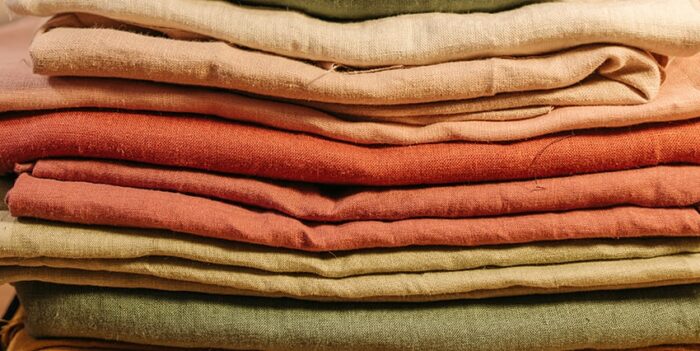Premium bed sheets and other linens often have anywhere between 600 and 1,200 thread counts. Thread count indicates the number of threads per square inch of fabric. The general belief is that a higher thread count equals better quality.
This number is only one part of the equation, though. You also need to consider the quality of the threads, as well as the type of fabric and other aspects. A 100% cotton sheet, for example, is more slippery and less soft than one made from bamboo fibers.
But what does thread count mean and why is it important? What’s a good thread for sheets, duvets, and other linens? Let’s find out.
What Does Thread Count Mean for Bed Linens?
We spend about a third of our lives in bed, so it makes sense to get the best linens we can afford.

Quality sheets and other bedding items are essential for a good night’s sleep. Cotton linens, for instance, are suitable for sensitive skin and tend to absorb body heat, keeping you cool at night.
Silk pillowcases reduce excessive sweating and hair frizz. Other fabrics, such as bamboo, are naturally resistant to mold, mildew, and dust mites.
Besides these aspects, you might also consider thread count when shopping for bed linens. This term describes the number of vertical and horizontal threads within a certain area, such as one square inch or one square centimeter of fabric.
Bed linens, towels, and other textiles are woven with weft and warp threads.
For example, a cotton pillowcase with 200 warp (vertical) threads and 200 weft (horizontal) threads per square inch of fabric will have a total thread count of 400.
These numbers are not always accurate, though.
Choice, a consumer advocacy group in Australia, says that there’s no industry standard for thread counts. Some companies count each fiber, or ply (and not just each thread) to inflate their numbers so they can charge more.
Does Thread Count Matter?
Thread count matters to some extent, but there are several other factors you should consider when shopping for bed linens.

Manufacturers use the term “thread count” to describe the quality and softness of different fabrics.
We’ve all seen ads featuring 1,000-thread-count Egyptian cotton sheets that cost double or triple the price of regular sheets. Marketers claim that higher thread counts indicate superior quality, increased durability, or even better sleep.
Sleep expert Michael J. Breus states that thread counts over 500 are just marketing hype. Many times, the fabric consists of two textiles woven together. This means that it’s not necessarily softer or of higher quality.
Ariel Kaye, the founder of a popular home decor brand, states that there’s a limit on how many pieces of thread can fit into a square inch. This number is around 400 for bed linens, she told Elle.
Kaye also says that some manufacturers inflate thread counts, often by up to five times the actual number. Some achieve these numbers of twisting weaker yarns together to make a thread. Others count each ply as a separate thread.
The bottom line is, if you see anything over 400, that’s likely an exaggerated figure. Bed linens with thread counts below 200, on the other hand, will be less soft.
Consider Thread Count and Ply
Thread count matters only when we’re talking about single-ply threads, which produce the softest and durable sheets. This factor is most relevant when it comes to cotton.
Manufacturers may use low-grade cotton to create multi-ply threads, notes Business Insider. This allows them to claim double or triple the thread count, but it doesn’t mean you’re getting softer or stronger sheets.

Polyester fibers and cotton/polyester blends are very thin, which allows manufacturers to increase the thread count. As you would expect, the final product will be less durable than pure cotton.
Silk, linen, and other fabrics have a different texture than cotton. Linen, for example, is thicker than cotton, while silk is much thinner. As a result, they cannot be compared to cotton in terms of thread count.
The fabric and the number of plies, as well as the yarn quality, are often more important than thread count. In textile manufacturing, ply is the number of yarns twisted together to form a single thread.
Bed linens with multi-ply threads can reduce airflow and increase sweating, affecting your sleep. Ideally, look for single-ply sheets and other linens made from long-staple or extra-long-staple cotton, recommends the Huffington Post.
The same source states that 180 to 280 thread count is often the best choice for quality bedding. A set of sheets with 200 to 350-thread count will be soft and durable while providing optimal comfort.
Prioritize Quality over Thread Count
High thread counts of 600, 800, or more use multi-ply threads. Therefore, you shouldn’t base your decision on thread count alone. Consider these factors, too:
- Fiber content (e.g.: cotton, bamboo, polyester)
- Fabric softness
- Staple length (look for long- or extra-long-staple fabrics when buying bed sheets)
- Diameter of the yarn (premium bed sheets use high yarn counts of 60 and up)
- Oeko-Tex certification
- Weaves, such as sateen, twill, or percale
- Ply (single-ply threads are the best option for sheets)
The above information should be listed on the label.

Cotton, linen, and other natural fibers are generally superior to their synthetic counterparts. These materials are strong and durable without sacrificing comfort.
Bed linens and other textiles with the Standard 100/Oeko-Tex label contain no harmful chemicals. These products are suitable for consumers with sensitive skin or allergies.
Not sure what to look for? Take into account these aspects:
- If you prefer silky, soft sheets, choose sateen. This fabric is wrinkle-resistant and has a luxurious feel. The downside is that it tends to wear faster than plain-weave or percale sheets.
- Linen is durable and keeps you cool at night, but it may feel rough on the skin. In general, it’s perfect for summer.
- Percale tends to become softer over time and makes a good choice year-round. The fabric is lightweight and breathable.
- Plain-weave sheets have a cool, crisp feel, which may help prevent overheating while sleeping.
- Twill-weave sheets are resistant to wear-and-tear, making them ideal for pet owners.
What matters most is how these fabrics feel against your skin. If possible, try to get a few samples before buying new linens. Check the fabric content on the label and ask about the tensile strength.
What’s a Good Thread Count for Sheets?
As discussed earlier, high-quality sheets have a thread count between 200 and 400. These numbers depend largely on the type of material.
- Premium Egyptian cotton sheets have a thread count between 300 and 400.
- Sateen weave sheets, by comparison, have a thread count of 300 to 600.
- If you plan to purchase bamboo sheets, look for brands with a thread count of 300 to 500.
- A good thread count for cotton sheets or percale-weave sheets is 200 to 400.
Consider these guidelines when shopping for pillowcases, duvet covers, and other linens—not just bedsheets. Note that silk, flannel, jersey, and microfiber linens are subject to different guidelines.

Except for silk, the above materials are measured in grams per square meter (GSM). The higher this number, the denser the fabric will be. Quality microfiber sheets, for example, have 90 to 120 grams per square meter, while flannel sheets are around 170 GSM.
The weight of silk is measured in momme. One momme equals 3.75 grams, or 0.13 ounces. Premium silk sheets typically have a momme count of 22 to 25.
Look Beyond the Numbers
When it comes to buying new sheets, it’s important to touch and feel. The numbers matter less.
We hope this guide answered your question—What does thread count mean? Now you know why a high thread count doesn’t always indicate superior quality or comfort. What you should focus on is the fiber content, staple length, ply, and fabric softness.
Don’t fall for the hype when comparing bed sheets and other linens.
Stick to the 200 to 400 thread count range (or slightly higher) to make sure you get the best value for the money. Check the labels, read product reviews, and ask for samples whenever possible.



